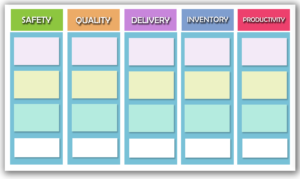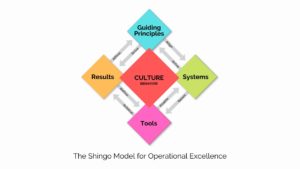A lean organization achieves its goals through the application of time-tested techniques and tools, backed by a firm philosophical foundation of continuous improvement and learning. Behind the lean paradigm are a set of management principles that when consistently applied, result in business success regardless of one’s industry.
What is Lean Management?
Traditionally, we expect management to be the function that is involved in the planning, organizing, directing and controlling resources to achieve organizational goals. In lean thinking, management is the systematic approach of enabling the organization to make its lean initiatives in a focused and efficient manner.
Most organizations fail to sustain their lean efforts due to lack of proper direction from management. The traditional approach of “control” does not work in a lean environment because it does not lend itself to the philosophy of empowering workers to find solutions to the business problems through observation, experimentation, and learning.
The old way of doing things sees managers as people who should provide all the answers to workers on the ground. In lean thinking, however, everybody works together with a clear focus on customer value and continuous improvement.
Lean Thinking Management Principles
The following 14 lean management principles which originated from Toyota provide the philosophical foundation required to achieve success in a lean system. Each has a set of tools that can be used to attain the organizational goals.
These tools are meant to assist a company in achieving results and should not replace a common sense approach to problem-solving. The application of lean tools must happen with the underlying principle in mind. In short, the theory drives the tool and not the other way round.
Long-term thinking
Lean thinking organizations have a clear vision of where they want to be in the future. They have a clear picture of what needs to be done to achieve these goals and do not get distracted by the expediencies of the moment. The first principle of lean management is:
“Make decisions based on your long-term vision even if means making sacrifices in the short-term.”
The lean tools that drive this principle are:
Hoshin Kanri is a strategic planning tool that ensures the whole organization is aligned to a common goal and leaves little room for diversion. Everybody knows where the company’s direction and their responsibilities in achieving these goals.
Nemawashi is a consensus-based decision-making approach that reduces the time taken to achieve results. By the time a formal meeting is held to make a decision, all involved parties have been consulted and have made up their minds on where they stand on an issue.
Flow the Customer Value
This principle deals with identifying wasteful activities that do not add any value to the customer. After determining the wasteful activities, have efforts are made to either eliminate or reduce them. You then align all the other steps in a continuous flow which increases productivity, quality, safety, and morale. There is also a marked reduction in costs as it requires fewer resources for achieving the same results.
The lean thinking tools that support this principle are:
Jidoka means building in quality into machines or process to prevent mistakes that have an impact on quality. This tool aims at capturing and correcting errors before they affect the next operation.
Line balancing is used to ensure that equal amount of work passes through the process to avoid the bottlenecks that hinder smooth flow of value
Cellular manufacturing increases flow by consolidating all the prerequisite steps that are required to assemble a product in one place. It also reduces the amount of time used when sub-assemblies move from one station to another
Produce at the rate of customer demand
Overproduction means “producing faster or more than the customer is demanding.” It is one of the most costly forms of waste as it encompasses all the known wasteful activities in lean manufacturing. By producing at a rate as close as possible to the real customer demand, costs reduce as there is very little unsaleable inventory in place.
The tools that support this principle are:
Kanban system is a signaling device that informs a process what to do next whether it is producing a new product or replenishing raw materials.
Takt time is a metric that determines the rate at which the end customer is demanding a product. All the processes must be synchronized with this rate to avoid non-delivery or over-production.
Level the workload
As companies cannot always produce at the exact frequency of customer demand, production must be evened out across production facilities to ensure prompt delivery. The system works by accumulating a good number of customer orders and then scheduling them at even intervals. Leveling reduces the waste and strain of trying to build to an erratic order.
The lean tool used to level the workload is:
Heijunka is the balancing of production to mitigate against the unpredictable spikes in demand that occur in a typical organization. Heijunka stabilizes the production process and ensures the optimal utilization of available resources
Quality right the first time
A fundamental tenet of lean thinking is that all methods must produce quality parts so that the end product to the customer is defect-free. This principle states that no process should produce, accept or pass on a defective part to the next step. Inspection is a wasteful process because resources have already gone into the production of faulty parts. The aim should be to capture defects before they occur.
The Jidoka tool is also applied here as a means of capturing and reporting the occurrence of a defect. Another closely related device is the andon which is also a signal to the process that an error has occurred that needs correcting.
Standardize and Improve
A standard is the best-known way of doing work. The principle of standardization serves as a reference point for further improvement and also as a means of training new workers on how to complete tasks. Without standards, there can be no way of improving in a lean system.
Improvement on the current way of doing things is a continuous process, and once improvement happens, a new standard must result. Rules are not cast in stone and will change through constant improvement. The tool used to support this lean principle is the Kaizen event.
Use visual controls
The purpose of visuals in a lean thinking organization is to communicate in a clear and unambiguous manner to the people working in a process as to the state of that process. Visual control is a lean tool used to bring problems to the surface and afford the workforce an opportunity to solve them.
When problems are hidden, there is no chance of solving them, and this leads to stagnation of the lean initiative. With visual controls, deviations from the acceptable standard are visible and countermeasure to bring the system back online can quickly be taken.
Tools used for visual control include:
5S is a systematic program that helps in orderliness and removal of waste
Process control boards show the status of processes and whether or not they are within specified limits
A3 reports capture all the necessary information needed in a summarized and concise manner to help in clear decision making
Use the right technology
Lean thinking organizations do not install technology just because it is the in-thing at the moment. They seriously consider whether the technology will assist them to achieve the goals or whether it will be an impediment to the attainment of value for the customer.
A good example is ERP & MRP systems. While many organization will rush to install these complex systems, lean thinking firms will first concentrate on the simple problem solving and waste removal tools they have at their disposal. If technology is deemed to be appropriate and relevant to their current issues, the lean thinking firms will surely go ahead and purchase them.
Leaders are grown, not bought
This lean management thinking philosophy calls for the development of competent leaders from within an organization rather than always hiring from outside. When this happens, the continuity of business is guaranteed because there is a constant pool of possible leaders who are ready to take over when the time comes.
This constant mentoring of leaders who thoroughly understand the work and live the philosophy of a company is critical in sustaining lean improvements because of maintaining institutional memory.
Personal development of people
Lean continually challenges team members to do their best to solve common business problems. By empowering the workforce to take charge of solving their problems, lean companies improve their skills which ultimately has a significant impact on the business.
The Job Instruction Method perfected at Toyota is one of the essential tools for improving the skills of the workforce in a lean environment.
Treat partners with respect
Treat suppliers and all other players in the extended enterprise with respect. This principle encourages cooperation and coordination within the extended enterprise which includes suppliers at all tiers. Suppliers and their suppliers are an essential part of the value chain that delivers the needs of the customer.
Lean thinking organizations work with their suppliers and help them to improve for the benefit of all the stakeholders. They understand that their success is dependent on the success of all in a win-win relationship that is defined by mutual respect and cooperation.
Gain a first-hand understanding of problems
This principal focuses on problem-solving that gets to the underlying causes by intimately interrogating the problem at source. The person trying to solve a problem must go to where the problem is occurring and observe the complex interactions of all the parameters before suggesting solutions.
Genchi genbutsu means “go and see” the source of a problem and find out what the exact causes are. It is a lean way of thinking that is not satisfied with second-hand reports but calls for real confirmation at the ground.
Build consensus before acting
Because business decisions affect many people, lean thinking organizations use this principle of agreement–building to communicate widely before any implementation. This agreement reduces resistance to lean programs and allows management to focus on the necessary actions required to succeed.
The nemawashi consensus-building approach is the fastest way to gain acceptance of lean initiatives through prior consultations before making final decisions.
Become a learning organization
This principle of lean management emphasizes the need for continuous evolution through constant reflection and re-adjustment based on the learning gained in the lean journey. Businesses must not stagnate in the past, but should continuously evolve to meet current and future challenges.


